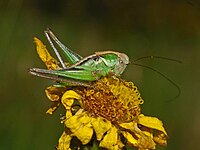Platycleis
| Platycleis | |
|---|---|

| |
| Platycleis grisea (type sp.) | |
| Scientific classification | |
| Kingdom: | Animalia |
| Phylum: | Arthropoda |
| Class: | Insecta |
| Order: | Orthoptera |
| Suborder: | Ensifera |
| Family: | Tettigoniidae |
| Subfamily: | Tettigoniinae |
| Tribe: | Platycleidini |
| Genus: | Platycleis Fieber, 1853 |
| Synonyms | |
|
Chelidoptera Wesmaël, 1838 | |
Platycleis is a genus of bush crickets described by Fieber in 1853,[1] belonging to the subfamily Tettigoniinae. The species of this genus are present in Europe, North Africa and temperate Asia.[2]
Biology[]
Studies conducted in 2010 at the University of Derby by Karim Vahed, Darren Parker and James Gilbert found that the tuberous bushcricket (Platycleis affinis) has the largest testicles in proportion to body mass of any animal recorded. They account for 14% of the insect's body mass and are thought to enable a fast re-mating rate.[3][4][5]
Species[]
The Orthoptera Species File[2] lists the following accepted species:
- Platycleis affinis Fieber, 1853
- Platycleis albopunctata (Goeze, 1778)
- (Uvarov, 1926)
- Massa & Fontana, 2011
- Galvagni, 1959
- Podgornaya, 1988
- Bolívar, 1899
- (Fabricius, 1775)
- Uvarov, 1912
- Platycleis grisea (Fabricius, 1781) - type species (as Locusta grisea Fabricius)
- Zeuner, 1941
- Uvarov, 1917
- (Serville, 1838)
- Sergeev & Pokivajlov, 1992
- Bey-Bienko, 1967
- (Uvarov, 1930)
- Ünal, 2012
- Stolyarov, 1968
- Tarbinsky, 1930
- Stolyarov, 1969
- (Zeuner, 1930)
- Zeuner, 1941
- † Zeuner, 1929
- Ramme, 1927
- Ramme, 1927
- Garai, 2011
- Azam, 1901
- Mistshenko, 1954
- † (Heer, 1865)
- Bey-Bienko, 1951
- Zeuner, 1930
- Costa, 1885
- Harz, 1966
Gallery[]

P. sp. nymph
References[]
- ^ Fieber FZ (1853) Synopsis der europäischen Orthopteren mit besonderer Rücksicht auf die in Böhmen vorkommenden Arten als Auszug aus dem zum Drucke vorliegenden Werke. Die europäischen Orthoptera. Lotos 3: 149.
- ^ a b Orthoptera Species File (Version 5.0/5.0 retrieved 8 February 2021)
- ^ Vahed, K.; Parker, D. J.; Gilbert, J. D. J. (2010). "Larger testes are associated with a higher level of polyandry, but a smaller ejaculate volume, across bushcricket species (Tettigoniidae)". Biology Letters. 7 (2): 261–4. doi:10.1098/rsbl.2010.0840. PMC 3061181. PMID 21068028.
- ^ Biggest testicles record set by bushcricket
- ^ Physorg link
External links[]
 Media related to Platycleis at Wikimedia Commons
Media related to Platycleis at Wikimedia Commons
Categories:
- Tettigoniinae
- Tettigoniidae genera



